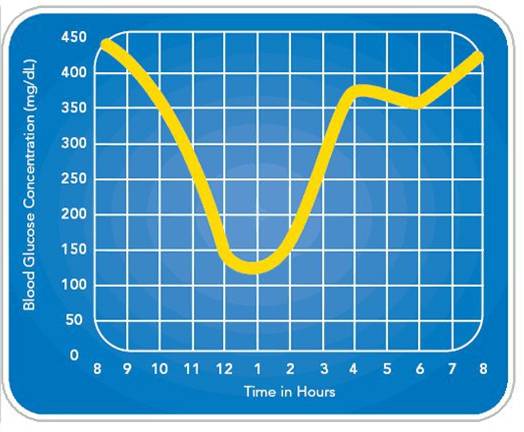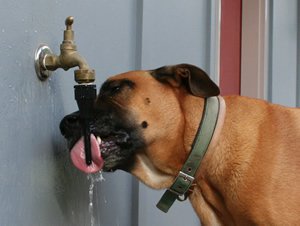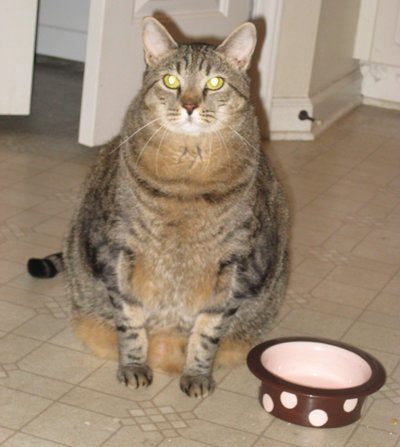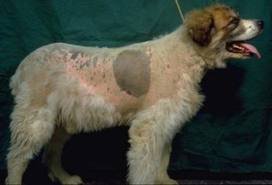| Monday | 8.30 - 6.30 |
| Tuesday | 8.30 - 6.30 |
| Wednesday | 8.30 - 6.30 |
| Thursday | 8.30 - 6.30 |
| Friday | 8.30 - 6.30 |
| Saturday | 9.00 - 5.00 (Closed 1.00-2.00) |
Diabetes
Diabetes (Mellitus) in Dogs and Cats
Diabetes mellitus is a disease that commonly occurs in dogs, as well as cats.
Diabetes mellitus occurs when the pancreas is unable to produce sufficient amounts of insulin, a hormone that converts glucose to glycogen for storage. Without insulin, the body's cells cannot absorb the glucose and the cells are in an energy deprived state. Meanwhile, excessive amounts of glucose remain in the bloodstream.
Types of Diabetes Mellitus
In humans, diabetes is divided into two categories. Type I is characterized by an inability of the pancreas to produce any insulin. Type II, also called adult onset diabetes, occurs when the pancreas does not produce enough insulin, often secondary to other diseases including obesity.
In animals, diabetes is not typically broken down into these types. While cats can develop insulin-dependent or non-insulin dependent forms, non-insulin dependent diabetes in dogs is extremely rare. Canine diabetes is nearly always insulin-dependent.
Canine Diabetes Mellitus Symptoms
Dogs can show a variety of signs that indicate diabetes mellitus. Unfortunately, these symptoms can also be present with other illnesses, so be sure to consult your vet if you notice these signs. The most common symptoms of diabetes include the following:
1. Increased thirst 3. Increased appetite 6. Poor coat One or more of the above symptoms may occur in diabetic pets but not necessarily all. |
Diagnosing Diabetes Mellitus in Dogs
Providing an accurate, thorough history to your veterinarian can be the key to discovering diabetes in your dog. The next steps will involve blood sampling; usually a comprehensive profile and a fructosamine sample will be taken. Fructosamine is a protein-sugar compound formed when glucose levels have been elevated for an excessive period. Occasionally other tests such as ultrasonography may be required.
Managing canine and feline diabetes
Canine and feline diabetes can be managed successfully and easily with correct diagnosis and treatment, which includes insulin therapy.
Pet owners play a crucial role in the successful management of their diabetic pets. Client education and good communication between you the veterinarian and pet owners is vital. Your attitude to diabetes will largely determine the pet owners' motivation and compliance with treatment.
Prognosis
The prognosis for canine or feline diabetes is good provided that it is diagnosed early and treated adequately.
Treatment Insulin for Canine Diabetes Mellitus
Insulin therapy is the cornerstone of diabetes management in dogs. Several insulin types are available for use in dogs. Your veterinarian will make insulin type and dosage recommendations based on your dog's specific needs and his or her past experiences.
Insulin is administered by injection, typically every 12 hours and after a meal. Before starting insulin therapy at home, you will be given a hands-on demonstration we will show you how to handle the insulin, how to draw it up in the syringe and how to inject it.
The ideal for any therapy is a nicely regulated glucose level following eating, this is often described as a curve and can be one of the ways that your pets glucose levels are monitored.

Complications of diabetes
Hypoglycemia
Some common symptoms are:
• depression/lethargy
• confusion/dizziness
• trembling
• weakness
• ataxia (loss of coordination and/or balance)
• vomiting
• Loss of consciousness and/or seizures
Successful home treatment of a hypoglycemia event depends on being able to recognize the symptoms early and responding quickly with treatment. Don't try to make a seizing or unconscious animal swallow though as there is a possibility of choking on the food or liquid. Sugar solution, honey or syrup can be rubbed onto the gums.
It's better to treat a possible hypo than to fail to respond quickly to the signs of actual hypoglycemia.
Dr. Audrey Cook addressed the issue in her 2007 article on diabetes mellitus; her statement is worth quoting:
"Hypoglycemia is deadly; hyperglycemia is not. Owners must clearly understand that too much insulin can kill and that they should call a veterinarian or halve the dose if they have any concerns about a pet's well-being or appetite. Tell owners to offer food immediately if the pet is weak or is behaving strangely."
“Hypos” don’t always have to be due to excess insulin, they can be through over excitement or exercise. I often advise owners to carry a sports gel sachet along with their pooh bags on walks.
Diabetic Ketoacidosis
Diabetes mellitus causes an inability to metabolize glucose, making the body think it is starving. In search of energy sources, the body breaks down fatty acids and causes the liver to produce organic acids called ketones. Excessive amounts of ketones can cause a life-threatening condition called diabetic ketoacidosis (DKA). Signs include vomiting, loss of appetite, depression, weakness, and breath that smells of acetone. DKA is a serious complication of diabetes mellitus that can lead to anemia, acute renal failure, electrolyte imbalance and neurological disorders. DKA occurs in undiagnosed or poorly controlled diabetics.
Diabetic Cataract
Cataracts are seen far more commonly in dogs rather than cats. Excess glucose present in the lens of the eye due to hyperglycaemia is converted into sorbitol, which causes an increase in the influx of water into the lens. The increase in water causes a breakdown of the lens fibres and disruption of the normal structure. The lens becomes cloudy resulting in loss of vision, usually in both eyes.
Treatment is possible through surgery. It is advisable to perform the surgery after the diabetic dog has been regulated successfully for at least 3 months.
Urinary Tract Infections
High blood sugar levels may become too much for the kidneys to filter, and glucose may "spill" into the urine and enter the bladder, because sugar promotes bacterial growth, urinary tract infections (UTIs) often occur. The overabundance of sugar can also lead to bacterial infections elsewhere in the diabetic dog.
Precautions
Here are a few key points to remember:
• Insulin should be kept refrigerated at all times
• Because it may separate in the bottle, insulin should be gently mixed before drawing it up. Gently roll the vial between your hands or rock it from side to side. Never shake the vial.
• Always be certain that you are using the proper syringes. Insulin comes in two concentrations: U-100 and U-40. Make sure the vial and syringes match.
• To inject insulin, make a "tent" with your pet's loose skin between the shoulder blades. Angle the needle slightly downward to prevent it from coming out from the other side of the skin.
• Do not give your pet insulin if he is not eating unless directed to do so by your vet. Your dog could receive an insulin overdose and develop hypoglycemia.
• NEVER alter your dog's insulin dose without consulting with your vet. Always follow your vet's instructions.
• Proper management is the key to providing quality of life for your diabetic dog, and it all comes down to teamwork with your vet, diligence on your part, and a true understanding of your dog.
For further information you can visit http://www.caninsulin.co.uk/
 Vets in Rugeley | Number 1 Vets
Vets in Rugeley | Number 1 Vets


